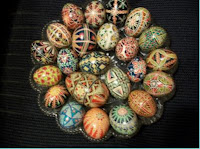The celebration of Dyngus Day is a very ancient Polish custom is
preformed on Easter Monday. The first
known writings on dyngus date back to the Middle Ages. Some tie this celebration to the 966 AD baptizing of Prince Mieszko and his court on Easter Monday. This custom is well documented in the Poznan Poland
Men would pour water on the heads of an
unsuspecting female friend or lover.
Dyngus began about 5 in the morning.
The house where the unsuspecting female lived would be secretly invaded,
sometimes with the collusion of the males of that household, and the females of
the house were doused liberally with water while some were still in bed!
Even though there was much screaming
and shouting by the girls, Dyngus was and still is considered a popularity contest. The more times in a day that a girl had to
change her dress, the more popular she was!
Reilly, the celebration is a strange type of courtship ritual! It was well known that the girl who was not dumped with water would not
be married in the next year.
When our ancestors came to the United States
My mom, Loretta Szostek Kolodzinski, told me of celebrating Dyngus Day when she was a child in Chicago. There would be a knock on the door and her sister, Phyllis, and her would run yelling and squeaking into the bedroom. They would crawl under the bed for protection but it would not last. Their father, Stanley Szostek, would show the boys the bedroom, lift the dust ruffle and point to his daughters hiding under the bed.
Even though this custom seems one sided, the women and girls had their days. From Easter Tuesday until Pentecost, this period of time was called the Green holidays, the women doused the men!
Dyngus Day is celebrated today in many locations in the USA, mostly where there are large Polish communities such as Buffalo, NY (the consider themselves the capital of Dyngus Day in America!), South Bend, IN, Chicago, IL, Elizabeth, NJ, Bristol, CT, and Pittsburgh, PA.
Dyngus Day is celebrated today in many locations in the USA, mostly where there are large Polish communities such as Buffalo, NY (the consider themselves the capital of Dyngus Day in America!), South Bend, IN, Chicago, IL, Elizabeth, NJ, Bristol, CT, and Pittsburgh, PA.










